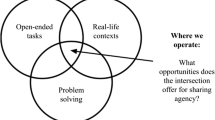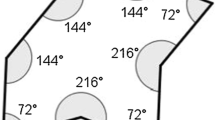Abstract
Contemporary curriculum demands the development of both problem solving skills and negotiative skills required for collaborative group work. Tasks are required that create the best possible conditions for students to develop both of these skill sets. Open-ended tasks have been shown to provide these conditions, but they also require the teacher to relinquish some level of control over student activity, since the open-endedness of the tasks provides students with the opportunity to realize their intentions rather than just the teacher’s. It is necessary to investigate the nature of the affordances created by the use of open-ended tasks in order to anticipate how they might best be used for both instruction and learning. What is needed is a structured way to identify the affordances offered by open-ended tasks. This paper reports a study conducted in a laboratory classroom equipped to record classroom social interactions in great detail using advanced video technology. The reported analysis addresses the following question: What are the foci of the students’ social interactions during collaborative problem solving while attempting open-ended mathematical tasks? Analysis was carried out in relation to each type of data generated: written response, transcripts and videos. Our research has identified structures to represent these affordances so that teachers can both anticipate them and draw on them in monitoring and facilitating student collaborative problem solving. The structured identification of affordances in relation to (a) written product and (b) negotiative focus provides teachers with two frameworks by which to scaffold student collaborative work while attempting open-ended tasks.





Similar content being viewed by others
References
Australian Curriculum Assessment and Reporting Authority (2015). The Australian curriculum v7.5: Mathematics. http://v7-5.australiancurriculum.edu.au/. Accessed 9 June 2017.
Binkley, M., Erstad, O., Herman, J., Raizen, S., Ripley, M., Miller-Ricci, M., et al. (2012). Defining twenty-first century skills. In P. Griffin, B. McGaw & E. Care (Eds.), Assessment and teaching of 21st century skills (pp. 17–66). Dordrecht: Springer.
Brousseau, G. (1986). Fondements et méthodes de la didactique des mathématiques. Recherches en didactique des mathématiques, 7(2), 33–115.
Brousseau, G., Sarrazy, B., & Novotná, J. (2014). Didactic contract in mathematics education. In S. Lerman (Ed.), Encyclopedia of mathematics education (pp. 153–159). Dordrecht: Springer.
Capar, G., & Tarim, K. (2015). Efficacy of the cooperative learning method on mathematics achievement and attitude: A meta-analysis research. Educational Sciences: Theory and Practice, 15(2), 553–559.
Chambers, D. L. (1978). Report on the Conference on Competency Based Mathematics Education, Madison, Wisconsin, January 13, 1978. Madison, WI: Wisconsin Department of Public Instruction.
Choy, B. (2016). Snapshots of mathematics teacher noticing during task design. Mathematics Education Research Journal, 28(3), 421–440. doi:10.1007/s13394-016-0173-3.
Clarke, D. J. (1996). Assessment. In A. J. Bishop, K. Clements, C. Keitel, J. Kilpatrick & C. Laborde (Eds.), International handbook of mathematics education (pp. 327–370). Dordrecht: Kluwer Academic Publishers.
Clarke, D. J. (Ed.). (2001a). Perspectives on practice and meaning in mathematics and science classrooms. Dordrecht: Kluwer Academic Publishers.
Clarke, D. J. (2001b). Untangling uncertainty, negotiation and intersubjectivity. In D. Clarke (Ed.), Perspectives on practice and meaning in mathematics and science classrooms (pp. 33–52). Dordrecht: Kluwer Academic Publishers.
Clarke, D. J. (2011). Open-ended tasks and assessment: The nettle or the rose. In B. Kaur & K. Y. Wong (Eds.), Assessment in the mathematics classroom (pp. 131–163). Singapore: World Scientific.
Clarke, D. J., Goos, M., & Morony, W. (2007). Problem solving and working mathematically: An Australian perspective. ZDM-The International Journal on Mathematics Education, 39(5–6), 475–490. doi:10.1007/s11858-007-0045-0.
Clarke, D. J., Keitel, C., & Shimizu, Y. (Eds.). (2006). Mathematics classrooms in twelve countries: The insider’s perspective. Rotterdam: Sense Publishers.
Clarke, D. J., Strømskag, H., Johnson, H. L., Bikner-Ahsbahs, A., & Gardner, K. (2014). Mathematical tasks and the student. In P. Liljedahl, C. Nicol, S. Oesterle & D. Allan (Eds.), Proceedings of the 38th conference of the International Group for Psychology of Mathematics Education and the 36th conference of the North American chapter of the Psychology of Mathematics Education (Vol. 1, pp. 117–143). Vancouver: The International Group for the Psychology of Mathematics Education.
Clarke, D. J., & Sullivan, P. (1990). Is a question the best answer? Australian Mathematics Teacher, 46(3), 30–33.
Clarke, D. J., & Sullivan, P. (1992). Responses to open-ended tasks in mathematics: Characteristics and implications. In W. Geeslin & K. Graham (Eds.), Proceedings of the 16th Conference of the International Group for the Psychology of Mathematics Education (Vol. 1, pp. 137–144). Durham, NH.
Clarke, D. J., Xu, L. H., Arnold, J., Seah, L. H., Hart, C., Tytler, R., et al. (2012). Multi-theoretic approaches to understanding the science classroom. In C. Bruguière, A. Tiberghien & P. Clément (Eds.), E-Book proceedings of the ESERA 2011 biennial conference: Part 3 (pp. 26–40). Lyon: European Science Education Research Association.
Collet, C., & Hine, D. (2010), Preparing graduates for both academia and industry. Australian Society for Medical Research (ASMR) Newsletter, p. 2.
CREA [Centre of Research in Theories and Practices that Overcome Inequalities] (2012). INCLUD-ED Strategies for inclusion and social cohesion in Europe from education: Final report. Spain: CREA, University of Barcelona.
Deming, D. J. (2015). The growing importance of social skills in the labor market. Cambridge, MA: National Bureau of Economic Research.
Goos, M., & Galbraith, P. (1996). Do it this way! Metacognitive strategies in collaborative mathematical problem solving. Educational Studies in Mathematics, 30(3), 229–260.
Griffin, P. E., McGaw, B., & Care, E. (Eds.). (2012). Assessment and teaching of 21st century skills. Dordrecht: Springer.
Hmelo-Silver, C. E., Chinn, C. A., Chan, C. K. K., & O’Donnell, A. (Eds.). (2013). The international handbook of collaborative learning. New York: Routledge.
Hummers-Pradier, E., Beyer, M., Chevallier, P., Eilat-Tsanani, S., Lionis, C., Peremans, L., et al. (2010). Series: The research agenda for general practice/family medicine and primary health care in Europe. Part 4. Results: specific problem solving skills. The European Journal Of General Practice, 16(3), 174–181. doi:10.3109/13814788.2010.504982.
Inoue, N., & Buczynski, S. (2011). You asked open-ended questions, now what? Understanding the nature of stumbling blocks in teaching inquiry lessons. Mathematics Educator, 20(2), 10–23.
Kosyvas, G. (2016). Levels of arithmetic reasoning in solving an open-ended problem. International Journal of Mathematical Education in Science and Technology, 47(3), 356–372. doi:10.1080/0020739x.2015.1072880.
Langley, P., & Trivedi, N. (2013). Elaborations on a theory of human problem solving. Advances in Cognitive Systems, 3, 1–12.
Lave, J., & Wenger, E. (1991). Situated learning: Legitimate peripheral participation. Cambridge: Cambridge University Press.
Marriott, P. (1976). Two hundred ways to subtract - most of them wrong. Paper submitted as part of the course requirements of the Bachelor of Special Education. Clayton, Victoria: Monash University.
National Research Council (2011). Assessing 21st Century skills: Summary of a workshop. Washington, DC: National Academy Press.
Newell, A., & Simon, H. A. (1972). Human problem solving. Englewood Cliffs, NJ: Prentice-Hall.
Nohda, N. (2000). Teaching by open-approach method in Japanese mathematics classroom. In T. Nakahara & M. Koyama (Eds.), Proceedings of the 24th Conference of the International Group for the Psychology of Mathematics Education (PME) (Vol. 1, pp. 39–53). Hiroshima, Japan.
Office of the Chief Scientist (2014). Science, technology, engineering and mathematics: Australia’s future. Canberra, ACT: Australian Government.
OECD [Organisation for Economic Co-operation and Development] (2013a). PISA 2012 results: Creative problem solving: Students’ skills in tackling real-life problems (Vol. V). Paris: OECD [Organisation for Economic Co-operation and Development].
OECD [Organisation for Economic Co-operation and Development] (2013b). PISA 2015 draft collaborative problem solving framework. Paris: OECD [Organisation for Economic Co-operation and Development].
Olive, J., & Steffe, L. P. (1990). Constructing fractions in computer microworlds. In G. Booker, P. Cobb & T. N. de Mendicuti (Eds.), Proceedings of the 14th annual conference of the International Group for the Psychology of Mathematics Education, with the North American Chap. (12th PME-NA Conference) (Vol. 3, pp. 59–66). Mexico: International Group for the Psychology of Mathematics Education.
Pazos, P., Micari, M., & Light, G. (2010). Developing an instrument to characterise peer-led groups in collaborative learning environments: Assessing problem-solving approach and group interaction. Assessment and Evaluation in Higher Education, 35(2), 191–208. doi:10.1080/02602930802691572.
Pólya, G. (1971). How to solve it: A new aspect of mathematical method (2nd edn.). Princeton, NJ: Princeton University Press.
Prediger, S., Clarkson, P., & Boses, A. (2016). Purposefully relating multilingual registers: Building theory and teaching strategies for bilingual learners based on an integration of three traditions. In R. Barwell, P. Clarkson, A. Halai, M. Kazima, J. Moschkovich, N. Planas, et al. (Eds.), Mathematics education and language diversity: The 21st ICMI Study (pp. 193–215). Cham: Springer International Publishing.
Remedios, L., Clarke, D. J., & Hawthorne, L. (2008). The silent participant in small group collaborative learning contexts. Active Learning in Higher Education, 9(3), 201–216. doi:10.1177/1469787408095846.
Roche, A., Clarke, D. M., Clarke, D. J., & Sullivan, P. (2014). Primary teachers’ written unit plans in mathematics and their perceptions of essential elements of these. Mathematics Education Research Journal, 26(4), 853–870. doi:10.1007/s13394-014-0130-y.
Schuster, K., Plumanns, L., Groß, K., Vossen, R., Richert, A., & Jeschke, S. (2015). Preparing for Industry 4.0—Testing collaborative virtual learning environments with students and professional trainers. International Journal of Advanced Corporate Learning, 8(4), 14–20. doi:10.3991/ijac.v8i4.4911.
Shimizu, Y., Kaur, B., Huang, R., & Clarke, D. (Eds.). (2010). Mathematical tasks in classrooms around the world. Rotterdam: Sense Publishers.
Stacey, K. (2005). The place of problem solving in contemporary mathematics curriculum documents. The Journal of Mathematical Behavior, 24(3), 341–350. doi:10.1016/j.jmathb.2005.09.004.
Steffe, L. P., & Wiegel, H. G. (1994). Cognitive play and mathematical learning in computer microworlds. Educational Studies in Mathematics, 26(2/3), 111–134.
Stein, M. K., & Lane, S. (1996). Instructional tasks and the development of student capacity to think and reason: An analysis of the relationship between teaching and learning in a reform mathematics project. Educational Research and Evaluation, 2(1), 50–80. doi:10.1080/1380361960020103.
Sullivan, P., & Clarke, D. J. (1988). Asking better questions. Journal of Science and Mathematics Education in South East Asia, 11, 14–19.
Sullivan, P., & Clarke, D. J. (1991). Catering to all abilities through “good” questions. The Arithmetic Teacher, 39(2), 14–18. doi:10.2307/41194944.
Sullivan, P., & Clarke, D. J. (1992). Problem solving with conventional mathematics content: Responses of pupils to open mathematical tasks. Mathematics Education Research Journal, 4(1), 42–60. doi:10.1007/bf03217231.
Sullivan, P., Knott, L., & Yang, Y. (2015). The relationships between task design, anticipated pedagogies, and student learning. In A. Watson & M. Ohtani (Eds.), Task Design In Mathematics Education: An ICMI study 22 (pp. 83–114). Cham: Springer International Publishing.
Sullivan, P., Warren, E., & White, P. (2000). Students’ responses to content specific open-ended mathematical tasks. Mathematics Education Research Journal, 12(1), 2–17. doi:10.1007/bf03217071.
Thomas, P. V., & Higbee, J. (1996). Enhancing mathematics achievement through collaborative problem solving. Learning Assistance Review, 1(1), 38–46.
Victorian Curriculum Assessment Authority (2016). Australian Victorian Essential Learning Standards (AusVELS). http://pandora.nla.gov.au/pan/129125/20121206-0015/ausvels.vcaa.vic.edu.au/index.html. Accessed 10 June 2017.
Viseu, F., & Oliveira, I. B. (2012). Open-ended tasks in the promotion of classroom communication in mathematics. International Electronic Journal of Elementary Education, 4(2), 287–300.
Webb, N. M. (1991). Task-related verbal interaction and mathematics learning in small groups. Journal for Research in Mathematics Education, 22(5), 366–389. doi:10.2307/749186.
Williams, G. (2000). Collaborative problem solving and discovered complexity. In J. Bana & A. Chapman (Eds.), Proceedings of the Mathematics Education Research Group of Australasia (pp. 656–663). Freemantle, Western Australia: Mathematics Education Research Group of Australasia.
World Economic Forum (2014). Matching skills and labour market needs building social partnerships for better skills and better jobs. Cologny/Geneva: World Economic Forum.
Wu, H. (1994). The role of open-ended problems in mathematics education. The Journal of Mathematical Behavior, 13(1), 115–128. doi:10.1016/0732-3123(94)90044-2.
Yackel, E., & Cobb, P. (1996). Sociomathematical norms, argumentation, and autonomy in mathematics. Journal for Research in Mathematics Education, 27(4), 458–477. doi:10.2307/749877.
Acknowledgements
This research was conducted with Science of Learning Research Centre funding provided by the Australian Research Council Special Initiatives Grant (SR120300015) and the Discovery Projects funding scheme (DP170102541). We would like to thank the students, parents, teachers, and school staff for their invaluable support of this project.
Author information
Authors and Affiliations
Corresponding author
Rights and permissions
About this article
Cite this article
Chan, M.C.E., Clarke, D. Structured affordances in the use of open-ended tasks to facilitate collaborative problem solving. ZDM Mathematics Education 49, 951–963 (2017). https://doi.org/10.1007/s11858-017-0876-2
Accepted:
Published:
Issue Date:
DOI: https://doi.org/10.1007/s11858-017-0876-2




